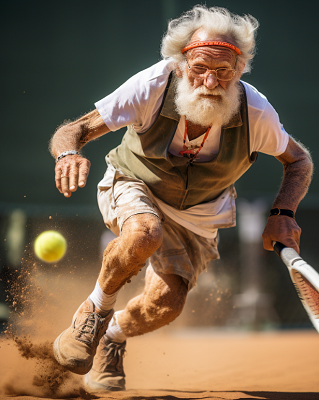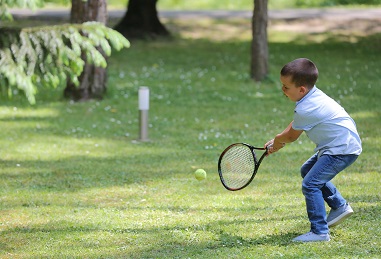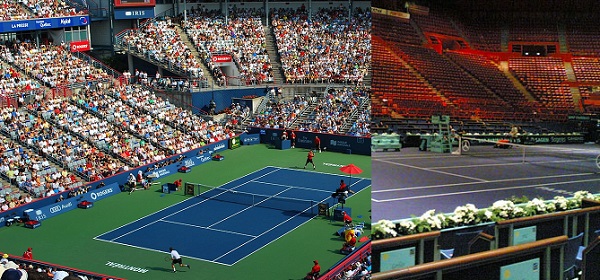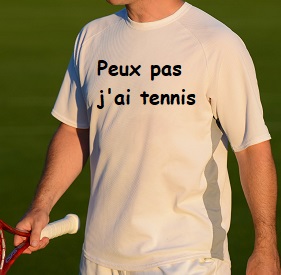Why tennis can be practiced at any age

Tennis, often referred to as the « sport for a lifetime, » is unique in its universal appeal. Regardless of age, tennis offers a plethora of benefits, both physical and mental, making it an excellent choice for people of all age groups.
Low impact on joints
Tennis stands out as a sport that is kind to the body, particularly when it comes to joint health. Unlike high-impact sports that can exert excessive strain on the knees, ankles, and hips, tennis offers a more moderate level of physical engagement. Especially when played on softer surfaces like clay or grass, the sport minimizes the jarring forces that can lead to joint injuries or exacerbate existing conditions. This gentler approach makes tennis an appealing option for individuals of all ages, from young players just starting out to seniors who are keen on maintaining their physical activity without compromising their joint health. Whether you’re executing a graceful volley or engaging in a baseline rally, tennis allows you to enjoy the thrill of the game while taking care of your body’s long-term well-being.
Customizable intensity
One of the standout features of tennis is its adaptability in terms of intensity. Players have the unique ability to tailor the game to their specific fitness levels and desired exertion. For beginners or those looking for a more relaxed pace, tennis can be played with gentle rallies and a focus on skill development. Conversely, for those seeking a rigorous workout or competitive challenge, the game can be ramped up to high-intensity exchanges with powerful serves and rapid volleys. This flexibility not only makes tennis accessible to a wide range of age groups and physical abilities but also ensures that players can adjust their game as they evolve, whether they’re recovering from an injury, seeking a challenging workout, or simply wanting a fun, leisurely activity. In essence, tennis offers a dynamic experience, allowing each individual to define their own pace and intensity on the court.
Social benefits
Tennis, at its core, is more than just a sport; it’s a social experience. Stepping onto the court often means engaging with a community of like-minded enthusiasts, fostering connections that extend beyond the boundaries of the game. Whether you’re playing doubles, participating in a local league, or simply rallying with a friend, tennis provides ample opportunities to interact and bond with others.
For younger players, tennis can be a platform to develop essential social skills, such as teamwork, communication, and sportsmanship. It offers them a space to make new friends, learn from peers, and navigate the dynamics of healthy competition.
Adults, on the other hand, can leverage tennis as a refreshing break from their routine, using it as a medium to network, forge new friendships, or strengthen existing relationships. The camaraderie that emerges from shared challenges and triumphs on the court can lead to lasting bonds.
For seniors, tennis serves as a conduit to stay socially active and engaged. Joining clubs or participating in senior-friendly matches can combat feelings of isolation, ensuring they remain connected to a vibrant community.
Moreover, the global appeal of tennis means that wherever you go, there’s a chance to connect with fellow enthusiasts. From local clubs to international tournaments, the sport offers a universal language that bridges cultural and geographical divides.
In essence, the social benefits of tennis are profound, turning each match into an opportunity for connection, growth, and community-building.
Mental sharpness
Tennis is not just a test of physical prowess; it’s equally a challenge of the mind. The game demands a blend of focus, strategy, and quick decision-making, all of which contribute to heightened mental sharpness. Every serve, return, and volley requires players to anticipate their opponent’s moves, calculate angles, and decide on the best course of action in mere seconds.
For young players, tennis can be a valuable tool in developing cognitive skills. The game teaches them to think critically, make swift judgments, and adapt to ever-changing scenarios. This kind of dynamic problem-solving can translate to improved academic performance and better decision-making in everyday life.
Adult players benefit from the mental stimulation that tennis provides. In a world where many tasks are automated and routine, tennis offers a refreshing break that challenges the brain. Regular play can help in keeping the mind agile, potentially delaying cognitive decline and enhancing overall mental well-being.
For older adults, the strategic aspect of tennis can be particularly beneficial. Engaging in activities that challenge the brain has been linked to a reduced risk of neurodegenerative diseases like Alzheimer’s. Tennis, with its requirement for tactical thinking and focus, can be a protective factor for brain health.
Beyond the strategic elements, tennis also teaches resilience, patience, and emotional regulation. Managing frustration after a missed shot, maintaining concentration during a long rally, or staying calm under pressure are all mental challenges that players face and overcome, further honing their mental fortitude.
In conclusion, tennis is as much a cerebral sport as it is a physical one. The mental challenges it presents and the cognitive benefits it offers make it a holistic activity that sharpens the mind just as effectively as it conditions the body.
Lifelong learning
Tennis, in its essence, embodies the principle of lifelong learning. Unlike some activities that can be mastered in a relatively short span, tennis offers a continuous journey of growth, refinement, and discovery. Every time a player steps onto the court, there’s an opportunity to learn, adapt, and improve.
For beginners, the learning curve might involve grasping the basics: understanding the rules, mastering the grip, or perfecting the serve. As they progress, the nuances of the game unfold, from developing advanced strokes to deciphering the intricacies of game strategy.
Intermediate players often delve deeper into the tactical aspects of tennis. They learn the importance of shot selection, court positioning, and reading their opponent’s tendencies. The game becomes a chess match, where anticipation and strategy play pivotal roles.
Even seasoned players, who’ve spent decades on the court, will attest that there’s always something new to learn in tennis. It could be a slight adjustment to their serve technique, a new spin on their backhand, or adapting to the evolving styles of newer generations of players.
Beyond the technical and tactical aspects, tennis also offers lessons in perseverance, resilience, and humility. A hard-fought match can teach a player about the importance of mental fortitude. A surprising loss can be a lesson in humility and the need for continuous improvement.
Furthermore, the world of tennis is ever-evolving. With advancements in equipment technology, changes in court surfaces, and the emergence of new playing styles, even veterans of the sport find themselves adapting and learning to stay relevant.
In essence, tennis is a mirror to life’s own journey of continuous growth and evolution. It reminds players of the joy of learning, the thrill of challenge, and the satisfaction that comes from self-improvement. Whether you’re 7 or 70, tennis offers a canvas of endless possibilities, ensuring that the spirit of learning never fades.
Health benefits
Tennis is more than just a game; it’s a holistic workout that offers a myriad of health benefits. Engaging in regular tennis play can lead to significant improvements in various aspects of physical and mental well-being.
Cardiovascular Health: Tennis is an aerobic activity that gets the heart pumping. Regular play can help improve cardiovascular endurance, reduce the risk of heart disease, and increase overall heart health.
Muscle Strength and Tone: The diverse range of movements in tennis, from powerful serves to quick lateral movements, helps in strengthening and toning muscles across the body, including the legs, arms, back, and core.
Flexibility: The dynamic nature of tennis requires players to stretch, reach, twist, and turn, promoting greater flexibility and range of motion.
Bone Health: Weight-bearing exercises like tennis can increase bone density and reduce the risk of osteoporosis, especially important for women and older adults.
Weight Management: Tennis can burn a significant number of calories, making it an effective sport for weight management and fat reduction.
Hand-Eye Coordination: The precision required in tennis, from timing serves to placing volleys, sharpens hand-eye coordination, which can be beneficial in daily activities and other sports.
Mental Well-being: Tennis is not just physically invigorating; it’s mentally therapeutic as well. The concentration and focus required on the court can act as a form of meditation, providing a break from daily stresses. Moreover, the endorphins released during physical activity can elevate mood and combat feelings of depression and anxiety.
Improved Sleep: Physical activity, like tennis, can lead to better sleep quality, helping players feel more rested and rejuvenated.
Enhanced Immunity: Regular exercise, such as playing tennis, can boost the immune system, making the body more resilient to illnesses.
Increased Longevity: Studies have suggested that tennis players may have a longer lifespan compared to individuals who don’t engage in regular physical activity.
In conclusion, tennis offers a comprehensive health package, catering to both the body and the mind. Whether you’re looking to improve cardiovascular health, gain muscle strength, or simply find a mental escape, tennis provides a pathway to a healthier, more vibrant life.
In conclusion, tennis is a versatile sport that caters to everyone, from the young to the elderly. Its adaptability, combined with its physical and mental benefits, makes it a top choice for those looking to engage in a sport that they can enjoy throughout their lives.





